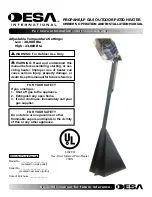
air extracted from the house continues to pass through
the exchanger.
In the appliance the by-pass valve opening can take
place in two ways:
Manual
, by pressing the MODE / SUMMER button on
the remote control;
Automatic
, when the appliance operates in AUTO
mode. In this second case, the valve opens by way of
Text > 15°C if one of the following conditions applies:
• if Tint > Tset: Text ≤ Tint
or
• if Tint ≤ Tset: Text > Tint
(Tset = temperature previously set using the remote
control)
The by-pass valve closes automatically in the other
cases.
Frost protection
: The appliance is fitted with an
automatic valve system that allows cold air from outside
to mix with warm air in the room where the unit is
installed.
The combined action of this valve and the automatic
adjustment of the airflows extracted from and entering
the rooms prevents the formation of frost on the heat
exchanger; this device consists of a valve which allows
the incoming cold air to mix with the warmer air from the
room in which the appliance is installed.
The frost protection procedure on the appliance works
as follows:
the valve begins to open automatically; at the same
time, the air intake fan increases in speed so as to
increase airflow.
If this action is insufficient, the outside air intake fan
speed is reduced, to mimimise the amount of heat
needed to heat it up.
If even this action is insufficient, the extractor fan for the
warm air from inside increases its speed, to increase the
heat contribution available, while the intake fan remains
at minimum speed.
Lastly, if even this measure should be insufficient when
faced with particularly bad external climate conditions,
in the absence of an optional heating element, the air
intake fan stops completely and the valve is closed,
while the stale air extractor fan continues operating.
After a certain period of time, the air intake fan starts
again at minimum speed, the valve re-opens and the
external conditions are checked again; if in the
meantime the temperature exceeds the threshold limit,
the actions described above take place in reverse order.
If atmospheric conditions in the room are beyond the
potential of the above-mentioned system, the (optional)
heating element situated upstream of the heat recovery
unit in the fresh air duct automatically cuts in for the
precise time dictated by the appliance and thus ensures
that the aim is achieved.
N.B.
The frost protection switching on prevents any change
to the status of the appliance. Any commands made will
not be carried out by the appliance, and the message
“DEF” will be displayed temporarily.
This will remain on the screen for a few seconds and will
then disappear and reappear every 15 minutes for as
long as the heating element is powered by automatic
data updates from the appliance to the remote control.
If a malfunction is detected in the heater, the word “ICE”
will flash on the remote control display and will be
followed by a single beep. Carry out the RESET
procedure. The heating element icon will continue to
flash, to indicate the heater fault. In this case, contact
the Technical Support Centre.
IMPORTANT: make sure that nothing is placed close to
the anti-frost valve, as this could obstruct its normal
operation.
Filters
Two F5 filters, placed inside the inlet and extraction
channels close to the heat exchanger and accessible by
removing the front panel, safeguard it from the
impurities contained in the extracted stale air and avoid
the introduction of polluted air into the dwelling served
by the system.
A further optional filter, of class F7, placed in the internal
duct after the F5 filter, can provide an additional filtering
capability.
The state of filter clogging is constantly monitored by
the system, completely automatically. The need for
maintenance/replacement is signalled, both visually and
acoustically, on the remote control.
Sensors
The appliance is equipped with three temperature
sensors, one relative humidity sensor, which integrates a
further temperature sensor, and a CO2 sensor. More
specifically, if the relative humidity, CO2
and
temperature sensors detect values above the threshold
levels, the appliance operation adapts automatically, to
restore normal environmental conditions or at least in
line with those set.
IMPORTANT
Before the appliance will work correctly, the CO2/RH(%)
sensor needs an average of 1 hour for auto-calibration
purposes.
29
ENGLISH
















































